Over ten thousand people gathered for the historic 40th Siyum Harambam in front of 770 Eastern Parkway on Sunday, Gimmel Tammuz. Here’s a full recap of the day’s events.
By Rabbi Shmuel Pevzner
Photos: Shimon Roumani
Over ten thousand men, women, and children, gathered at the conclusion of the holy day of Gimmel Tammuz for the “Siyum HaRambam HaOlami” –as it was named by the Rebbe– celebrating the completion of the 40th cycle.
The Siyum took place facing the Rebbe’s room and the Rebbe’s beis midrash, where he launched the Rambam campaign and subsequently made the first Siyum on Yud Alef Nisan 5745. With mixed emotions, the crowd felt the specialty of this day together with the joy over the special milestone marking the 40th Siyum.
“Not Since Gimmel Tammuz 27 Years Ago”
It was moving to hear from the Crown Heights Police Chief that there wern’t so many people on Eastern Parkway since Gimmel Tammuz 27 years ago. The police estimated that there were well over ten thousand participants at the Siyum.
Several hours prior to the Siyum, the NYPD closed all the streets leading to the area in front of 770. Already from the morning, huge trucks unloaded the large and well-equipped stage, giant screens, amplifiers, thousands of elegant and comfortable chairs, metal barricades, and everything that was necessary for holding the event in an organized and secure manner.
As the appointed time approached, over ten thousand men, women, and children flocked from every direction. Based on illustrated maps distributed in advance, the men arrived through Kingston Ave and the women from Brooklyn Ave, and they took their seats all along the parkway spanning from Albany Ave to Brooklyn Ave. Every chair had a beautiful study schedule for the 41st cycle and an elegantly designed card with the final and first halachah in Rambam, and the order that the Rebbe’s niggunim would be sung throughout the evening.
The chairs quickly filled up, and the overflow crowd began standing in the side areas prepared in advance for this.
A 5:30 AM Chavrusa in 3 Perokim
Exactly on schedule, as an introduction to the event, a video presentation was shown, showcasing the story of R’ Shloimy Greenwald, a chassidic businessman in Crown Heights, whose day is full with business activities and the great work he does for the Rebbe’s inyanim.
R’ Shloimy described his daily Rambam study, how he reached the decision to learn three chapters a day, and his efforts to find a conducive time to learn, until he found a chavrusa to learn with every morning at 5:30 AM. This short clip left a strong impression on those gathered, when they saw how a successful businessman isn’t ready to forgo studying the daily Rambam properly with understanding, and has been waking up early every morning to do so consistently.
Tzama Lecha Nafshi!
Immediately afterwards, the event began. The Rebbe’s niggun “Tzama lecha nafshi” echoed across Eastern Parkway, led by Avraham Fried and the Kappelle choir of Yossi Cohen and music by Chony Milecki. The crowd sang harmoniously.
It’s impossible to not get swept up in the unique atmosphere: Gimmel Tammuz amongst thousands of chassidim. Oy, does my soul thirst – Tzama lecha nafshi!
The chassidic Chazzon Rabbi Shneur Zalman Baumgarten is called upon to lead the recitation of the Rebbe’s kapitel. The entire crowd stands with respect, and the pesukim of kapitel 120 are displayed on the screens.
Sisu v’Simchu!
“Opening with a Dvar Malchus,” a clip was shown of the Rebbe making the Siyum on the first study cycle at the height of the farbrengen on Yud Alef Nissan 5745. During the preceding niggun, the Rebbe takes out copies containing the final halachah in Rambam as well as the first, and then begins the Siyum and famous hadran. Afterwards, the crowd bursts out singing Sisu v’Simchu and the Rebbe’s face is shining with joy—a joy that is amplified 40 times by this Siyum on the 40th cycle.
The emcee, Rabbi Shmuel Butman, Director of the Central Lubavitch Youth Organization and Chairman of the “International Siyum HaRambam,” announces: “Welcome to the Siyum Harambam on the 40th cycle!” Rabbi Butman sharpens the focus by pointing out, “Everyone can see that something wondrous is happening here! The last Siyum took place on Shiva Asar b’Tammuz, The present Siyum of the 40th cycle is on Gimmel Tammuz! One can’t ignore the fact that there is something very special involved here.”
A Sign of the Imminent Geulah
Rabbi Butman spoke of the forty years the Jewish people waited in the desert before entering Eretz Yisrael. We are currently in a similar situation. They waited for the number “Forty” – fourty years — to get out of the Golus of the desert on go into “the promised land” and we are in Golus waiting to enter Eretz Yisroel with the true and complete geulah. Then comes the number “Fourty” — of the 40th Siyum—and informs us that “the time for your redemption has arrived.”
Right outside of the Rebbe’s window!
This is especially so, continues Rabbi Butman, as we gather with unity right outside of to the Rebbe’s window. The Rebbe is with us! The Rebbe has much satisfaction that his children came to him and have gathered together in this special place, right outside his window, on the special day of Gimmel Tammuz.
A wondrous way to strengthen our connection with the Rebbe is to join the Rebbe’s campaign by studying three chapters or one chapter of Rambam daily for men, and Sefer Hamitzvos for women and children.
Message of the Chief Rabbi
The Chief Rabbi of Eretz Yisroel, the gaon Harav Dovid Lau, sent his blessings now being displayed on the screen. Rabbi Lau pointed to the Rebbe’s great vision in limud haRambam, and stressed the uniqueness of the fortieth Siyum, based on the posuk in Tehillim, “Arabaim shanah akut bedor.” Moshe told the Jewish people that until their fortieth year in the desert, Hashem did not give them a “knowing heart,” and after forty years, a student can appreciate the depth of his Rebbe’s teachings. Rabbi Lau concluded with blessings for all those who learn Rambam.
Jewish Unity through Torah
Harav Avrohom Osdoba, the mara d’asra and member of Crown Heights Beis Din, quoted Rabbi Akiva that “V’ahavta lerei’acha kamocha – loving a fellow Jew” is a great principle of the Torah. Ben Azzai, however, argues that “Zeh sefer toldos adam” is the great principle of the Torah. Ben Azzai’s view, explained Rabbi Osdoba, is that unity between Jews is created through their connection to the “sefer,” the Torah. This is the accomplishment of the Rebbe’s takanah, uniting the entire Jewish people through a shared study of the entire Torah Shebaal Peh.
The meaning of the term “Takono”
Harav Yosef Yeshaya Braun, the mara d’asra and member of Crown Heights Beis Din, pointed to the uniqueness of this Siyum, as it joins the list of Siyumim coinciding with special days—beginning from the very first Siyum on Yud Alef Nisan, the Rebbe’s birthday, and the third one on Yud Shevat, the hilula of the previous Rebbe and the kabalas nesius of the Rebbe, and now a Siyum on Gimmel Tammuz. Harav Braun made mention of the gaon Harav Aharon Yaakov Schwei a”h, member of the Badatz, who participated in every Siyum.
Besides all the side advantages of learning Rambam, explained Harav Braun, for us chassidim, it is the way we strengthen our connection to the Rebbe. The Rebbe explained why certain things are called “takanos” and not “mitzvos,” since their purposed is improve and perfect those who fulfill the takanah. The rov encouraged the audience to resolve on Gimmel Tammuz to add in all aspects of limud haRambam—in consistency and depth.
Avraham Fried and the Kapelle are now invited to sing another two of the Rebbe’s niggunim, Shamil and Stav Yapitu.
Connecting to the Rebbe
The chairman, Rabbi Butman, called attention to the fact that when chassidim sat together and said L’chaim, they knew that the best way to connect with the Rebbe is by singing the Rebbe’s niggun, envision the Rebbe’s image, and visualize that you are standing in front of the Rebbe. This, said Rabbi Butman, is the pleasant task of Avraham Fried and the Kapelle.
Completing a Full Circle
Before beginning to sing, Avremel turned to the crowd with emotion and related that he merited to sing by the Siyum on the first cycle in Yerushalayim on Chol Hamoed Pesach 5745, and he received a special bracha from the Rebbe for that trip. “Now, I have the merit to sing by the historic Siyum on the fortieth cycle. Thank you Rabbi Butman for granting me this privilege!” Then he began the niggun of Shamil, expressing intense yearning, and drew the crowd to join in.
Learning Rambam as part of our day
A special guest, the Rebbe’s shliach and chief rabbi of Eilat, Harav Yosef Hecht, spoke of the significance of a “takanah,” an institution. The Yerushalmi says that Moshe Rabbeinu instituted that the Torah portions related to the festival should be read on the festivals, and he also instituted the seven days of celebration after a wedding. Would someone even consider not reading the Torah on Yom Tov? Would anyone agree not to hold sheva brachos for one reason or another? The same applies to the Rebbe’s takanah: it may not be postponed or skipped, chas veshalom, due to exhaustion or any other reason. Everyone can find time for a quality study session in Rambam.
It’s Time for Moshiach!
Harav Hecht continued to quote the famous Gemara that Hashem wanted to designate Chizkiya as Moshiach. Chizkiya promoted the study of Torah to the point that they searched in his time from Gevas to Antipatris and did not find a boy or girl who was not expert in the complex laws of tuma and tahara. Look what happened as a result from the Rebbe’s takanah—from Moscow to Melbourne and from Eilat to New York, there are thousands of Jews who are proficient in all of the Torah’s laws! Under these circumstances, Moshiach has to come!
Jewish Unity!
Harav Leibel Wulliger, Rosh Kollel of Torah Vodaas and representative of the Rebbe of Munkatch is invited to speak. Rabbi Wulliger also represented Chassidus Klausenburg as his father, Harav Binyomin Wulliger a”h, participated in the Siyumim representing Chassidus Klausenberg.
Harav Wulliger could not contain his excitement and cried out from the depths of his heart, “Here, in front of 770, I was by the Lag BaOmer parade with the Rebbe. I saw thousands of children passing in front of him and the Rebbe waved his holy hand to each one. Today, I have the merit to participate in the Siyum Harambam in the same place!” He continued to speak passionately about Jewish unity and that the Rebbe wants us to unite with one another through this shared study of Rambam.
A Charming Children’s Choir
At this point, there was a professional and touching performance by the children’s choir of Cheder Ohr Menachem, where they sang niggunim that were composed for the Rebbe’s kapitelach over the years. With the unique chein – charm — reserved for soldiers of Hashem, the children quoted the final halachah in Rambam. The crowd derived much enjoyment from these pure young souls and responded with a strong round of applause.
It’s the way you Daven!
Harav Dovid Kampinski, Rov of the Gur community in Boro Park, related a story. A certain rov would sometimes skip the beginning of davening in order to keep up with the minyan, as the Shulchan Aruch rules, but he didn’t have success in learning. He eventually came to the previous Rebbe, who asked regarding his daily schedule. The rov began by describing his study schedule, but the Rebbe told him, “You skipped a description of your davening.” The rov then admitted that he skips parts of davening and the Amshinover Rebbe already commented to him about it. The Rebbe told him, “The expression goes, ‘Your Torah follows the way you eat’; we say, ‘Your Torah follows the way you daven.’”
Harav Dovid Kampinski went on to discuss how we find ourselves in the forty days of favor following Matan Torah, and now we have completed forty cycles of Rambam. May we continue until the fulfillment of the prophecy brought in the conclusion of Rambam, “The earth will be filled with knowledge of Hashem as water covers the sea.”
Author of Eighteen (!) Seforim on the Rambam
Rabbi Butman shared the deliberations who to honor with the historic Siyum. The decision was that there is one Jew who did not only learn Rambam; he teaches Rambam to the masses and wrote eighteen (!) seforim on the Rambam. This is none other than the gaon, Harav Yitzchak Raitport, the Rosh Kollel Metzuyanim in Boro Park and author of the series “Bidvar Melech” on the Rambam.
A new depth of understanding
Harav Raitport concluded the Rambam by learning the final halachah, and pointed out how so many thousands of Jews finished forty study cycles. The Rebbe chose Rambam not only because it contains the entire Torah, but also because it provides a new depth of understanding in Torah. The Rebbe says that even one who studies three chapters a day should learn at least one halachah with the proper depth.
The “Gavra” (individual) and the Cheftza (situation of the world) of Moshiach
“We will just say a short insight on the conclusion of the Rambam. The Rambam writes that there is no difference between this world and the days of Moshiach besides our emancipation from our subjugation to the general kingdoms.
“The commentaries ask various questions on this, and point out that the Rambam contradicts what he himself rules regarding wearing weapons on Shabbos. If there won’t be subjugation to the nations, why will we still wear weapons? Also, saying that ‘good will flow in abundance’ sounds like it will be a big change from the time of exile?
“The explanation is that the situation in the world, resulting from the Torah study and mitzvos from so many years, will be that delights will be freely available as dust. This is the cheftza of the world’s condition. But for the individual, the gavra, it is still possible that someone will be poor, G-d forbid. That is why ‘there will be no difference…’
“In Hilchos Teshuvah, the Rambam is discussing the cheftza, while in Hilchos Moshiach he speaks of the gavra, where there will still be different levels. One who learns a lot of Torah will have the delights available like dust and he won’t have any material concerns to disturb his learning.
Becoming a different person
The Rambam in Hilchos Talmud Torah writes about “Kesser Torah.” (“The Crown of the Torah”) Many ask what is the definition of those terms. When a person learns and delves deeply into the Torah he becomes a different person. This is the Rebbe’s takanah—to learn properly until we are elevated to be like a different person, and this we will see in a complete sense by the geula.
“The Rebbe made a takanah for everyone—for all levels of Jews—and in this way we achieve two things: Jewish unity, and also learning the entire Torah and learning, at least part of it, in depth.
“The Maggid told R. Elimelech of Lizhensk that one should love a Jew at the other end of the world just as he loves those close to him. The Rebbe united all Jews through Torah study, until we will merit the coming of Moshiach” concluded Horav Raitport
The Entire Torah Is Included in Rambam
The former Chief Rebbi of Israel, Rishon Letzion, and the chief Rabbi of Yerushalayim, Hagaon Harav Shlomo Moshe Amar, was called upon to commence the forty-first cycle. The Rabbi was received with applause from the crowd, and made his way to the podium as music played. He began by reciting the posuk Viyhi Noam twice, as is the Sefardic tradition before beginning holy matters. Then he read the first halachah in Rambam, “Yesod hayesodos…” “These are Divrei Elokim Chaim!” called out the Rabbi with excitement.
The chief Rabbi continued to speak of the greatness of the Rebbe’s takanah to learn Rambam, which includes the entire Torah—even the laws that don’t apply during golus. “On this great and holy day, the hilula of the greatest among the giants, the Rebbe—whose merit should protect you and us—we are completing the study of Rambam for the fortieth time!
“The Rebbe—before whom the entire Torah was revealed and no secret of Torah escaped him—chose the Rambam. The Rebbe made Rambam accessible to the masses. Before this, people did not learn Rambam in order, rather one halachah here and one there. The Rebbe made it a daily study, and it isn’t just for Chabad chassidim; it spread to others as well, and tens of thousands learn Rambam—this is a great zechus.
“We don’t have any other sefer that includes all halachos of Torah. The Shulchan Aruch only contains portion of the halachos. Even in the Shulchan Aruch, almost ninety percent of the language is taken from the Rambam. The Bet Yosef knew that there is no language as precise as the Rambam, thus he didn’t only follow the Rambam’s decisions but his language as well. The entire Torah—all that is written in the Talmud Bavli, Yerushalmi, Midrashim, Zohar—is contained in the Rambam’s golden language. Concluding the fortieth cycle makes this a great and holy day!”
The chief Rabbi spoke of the difficult times we are living in, after the recent tragedy in Meron on the holy day of Lag BaOmer, and then afterwards more tragedies and warfare; this all coming after one and a half years of a pandemic that wreaked havoc in the world.
“Yeshayahu Hanavi (1:5) says, “Why are you beaten when you still continue to rebel? Every head is [afflicted] with illness and every heart with infirmity.” This is to wake us up, that we shouldn’t just say it is a coincidence. To dismiss a head illness as a mere natural thing—“Every head is afflicted”—is considered rebellious. As the Rambam writes in Hilchos Taanios (1:3) that to say, “What has happened to us is merely a natural phenomenon and a chance occurrence– is cruel.” It is cruel to himself, his family, and his nation.
“We must eradicate machlokes from amongst us. To rid ourselves of any animosity, jealousy and competition that is not for the sake of heaven. We find ourselves in the darkness of golus, ‘This night – only maror.’ – a bitter night.
“We merited to visit the Rebbe’s Ohel today; we made a hakafah (circle) and davened the tefilah of the Rashash. Afterwards, I cried out in pain and I told the Rebbe that his holy honor fought his entire life to bring Moshiach. I don’t know if there was any other person who fought as he did in all possible methods to strengthen and bring closer to Torah and mitzvos, in order to bring Moshiach closer.
“It’s impossible to say that he’s not coming. We are certainly in the process of his coming, but it is taking a long time. We don’t have the strength to continue enduring the golus, Ad Mosai Hashem! We ask on this day, which is the Rebbe’s day, the Rebbe’s hilula, that he should continue his great fight, he should stand before the Kisei Hakavod (heavenly throne) and bring the cry of the entire Am Yisrael, telling Hashem that He should send us Moshiach and speed up our redemption.
“We are crying out from the depths of our hearts that Hashem should say ‘Enough’ and send a spirit of purity and holiness on Am Yisrael. With Hashem’s help, we will see the coming of our Moshiach, in complete revelation, speedily in our days, Amen v’Amen.”
Rabbi Butman thanked the chief rabbi and Rishon Letzion, and blessed him in the name of the entire congregation with long and pleasant years, and that he should merit to see the complete geulah teikeh umiyad mamosh, imminently.
Achdus –Unity will bring about the coming of Moshiach.
The shliach and chief Rabbi of Russia, Harav Berel Lazar, began by quoting the posuk brought at the end of the Rambam, “The world will be filled with the knowledge of Hashem.” “This is happening right now, when the police closed Eastern Parkway for the Siyum HaRambam—one would never imagine such a thing!” Harav Lazar continued to discuss the achdus – unity, that is so necessary. A prime example is the unity prevailing at the Siyum, which should serve as a precedent for the entire world, and a preparation for the times of Moshiach when there will be no animosity or competition.
3 Perokim. One at Shachris. One at Mincha and one at Maariv.
“I want to suggest something to you that I do in my community. We learn one Perek of Rambam to Shchris, one Perek to Mincha and one Perek to Maariv,” said Rabbi Lazar. The crowd responded with applauds.
The Rebbe: “Did you speak at the Rambam?”
Harav Gavriel Zinner, author of Halachic seforim and Rabbi of Congregation Nitei Gavriel—whom the Rebbe himself asked if he spoke by the Siyum—said speaking in 770: “On Lag BaOmer 5745, the Rebbe said that it is stated explicitly in the Gemara that when a teaching of a talmid chacham is quoted in this world, their lips move in their grave. This means that when a Jew learns Rambam—even with only the simple meaning—the Gemara rules that this causes the Rambam’s lips to move.
“Think about it: A Jew who studies Rambam accomplishes that the Rambam should leave aside all his occupations in Gan Eden, and make the effort to come down to this world, to his resting place in Teverya, and there his lips are moving physically, as if talking.
“It can be added that since his lips are moving in the grave, this effects a change in the air around the lips, and ultimately and change in the air of the entire world. The way Hashem setup nature is that when there is movement in one part, this causes additional movements in the surrounding air, and this chain continues to affect the entire world.
Learning Rambam Affects the Air in the Entire World
“Based on this, we can understand what is brought from tzaddikim that learning Rambam is a segulah good merit, to be saved from a plague. The Rambam, besides for his great prowess in Torah—‘From Moshe to Moshe there arose none like Moshe’—he was also a tremendous doctor. This is especially the case with an illness that travels through the air.
Since the Rebbe established that learning Rambam ‘effects a change in the air of the entire world,’ certainly this zechus will bring healing for all Jews wherever they live, and very soon we will merit to great Moshiach tzidkeinu, speedily in our days, Amen.”
The Rebbe sends a message
Harav Yechiel Michel Daskal, Rosh Yeshivah of the Vizhnitzer Yeshivah Tzemach Tzadik, opened the recorded message by saying: “In my eyes it is currently t’hei shnas arenu p’laos—I am consistently amazed how the Rebbe’s Torah contains allusions to the idea at hand.
“When Rabbi Butman invited me to the Siyum on Gimmel Tammuz, my heart shivered. The Siyum is on the special day of Gimmel Tammuz.
Gimmel Tammuz shows that the sun does not set!
“Gimmel Tammuz in the Rebbe’s Torah is a vast world, but I will need to suffice with what time allows. In the farbrengen of Shabbos Korach, Gimmel Tammuz 5745, the Rebbe says that Gimmel Tammuz is a meritorious and special day. (1) It marked the beginning of the Privious Rebbe’s redemption, when he left jail for exile in Kostroma; and (2) it is brought in Seder Olam Rabbah that Gimmel Tammuz is the day that Yehoshua told the sun to stand still.
“This teaches us that on this day, the sun does not set, rather shines and illuminates forever.
Yehoshua Showed the “Mishneh Torah” to the Sun on Gimmel Tammuz
“The Rebbe also brought from the Midrash that Yehoshua showed the sefer Mishneh Torah to the sun and said, ‘Just as we don’t stop learning the sefer, you sun should not set.’ “On this very day, we are completing the Mishneh Torah of the Rambam”
“In the sichah of Gimmel Tammuz 5727, the Rebbe spoke how it is forty years from the geulah in 5687, which is when a person can appreciate the teachings of his Rebbe. This is a hint to Gimmel Tammuz of this year, when we are completing the fortieth cycle.
“There are many more allusions that the Rebbe had the present Siyum in mind.”
Also participating in the Siyum was the representative of the Skverer Rebbe, Harav Shmuel Yosef Prizel, the Skverer Dayan in Boro Park.
The soldier in Tzivos Hashem, Hillel Pevzner, was honored with learning the final mitzva of Sefer Hamitzvos, mitzvah #264, on behalf of all those who learned Sefer Hamitzvos.
Thank You to Everyone Who Made the Event Possible
The chairman thanked the NYPD for all their tremendous assistance that brought to the event’s success, and the security that they provided, especially Mike Barata and Sergeant Kelly. The chairman thanked Rabbi Chanina Sperlin and all those who worked days and nights for the evening’s success: his son Rabbi Yosef Yitzchak Butman and Rabbi Shmuel Pevzner. The temimim: Menachem Mendel Mintz, Aharon Dovid Rapaport, Meir Shlomo Zaltzman, Menachem Mendel Piekarski, Aryeh Pevzner, Shmuel Butler and Menachem Mendel Braun together with tens of other temimim who worked with great dedication for the event’s success.
The chairman thanked the donors who made the event possible: Keren Meromim, Beis Shmuel-Chabad, Rabbi Moshe Pinson, Rabbi Shloimy Greenwald, and Rabbi Yerachmiel Jacobson. “Der Rebbe blaibt nit kein baal choiv” – “The Rebbe does not remain in debt.”
At this point, videos of the Rebbe speaking about “Mah zaro bachaim” were shown together with other rare footage.
“The Street Danced”
Avraham Fried and the Kapelle continued to sing and brought that the entire crowd stood up and began to dance. It was an amazing sight to see thousands of chassidim dancing on Eastern Parkway. This was reminiscent of the Rebbe Maharash’s words when he saw through the window how the chassidim were dancing by the chassuna of his son, the Rebbe Rashab: “This is how the chassidim will dance when Moshiach comes.”
As the crowd left, the temimim from the organizing crew distributed three beautiful mementos to each participant: (1) a tadfis from the Pardes Hemelech Rambam by Rabbi Meir Elituv, which collects two thousand explanations of the Rebbe on Rambam; (2) a preview edition from the new sefer Otzar HaMelech, by Rabbi Yosef Yitzchok Lipskier, printed specially for the Siyum; and (3) the Chayenu for the week, containing the daily study portions—including Rambam—with English translation. The organizers and participants thank the publishers for their generosity and the merit of the public is thanks to them.
“Next Year in Yerushalayim!”
The chairman announced that the custom is to announce at the conclusion of the Siyum the date and location of the next Siyum. Therefore, he announced that the next Siyum will take place on erev Lag baOmer 5782, with the Rebbe, the Rambam and Rabbi Shimon Bar Yochai, in the holy city of Yerushalayim.
As is customary after the Pesach Seder, the chairman announced “Next year in Yerushalayim,” and the crowd repeated, “Next year in Yerushalayim!”
“More benches in the Beis Hamidrash”
The reactions to the Siyum Horambam where overwhelming as they were heartwarming. A great number of people accepted upon themselves to start learning Rambam every day. That is exactly what the Rebbe wants.
Video: Full Event Replay
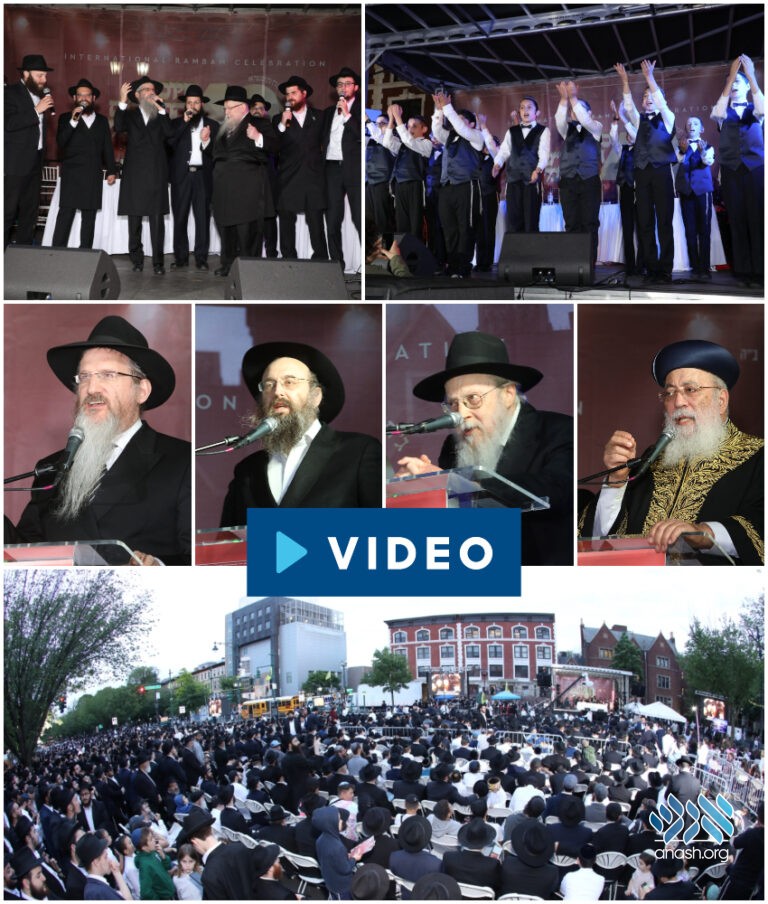

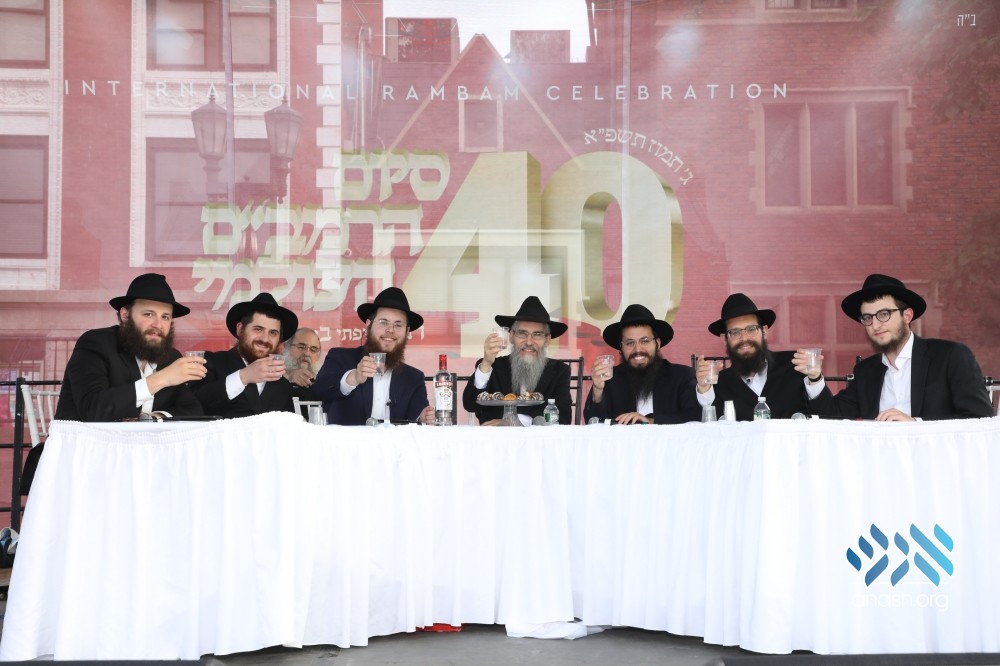

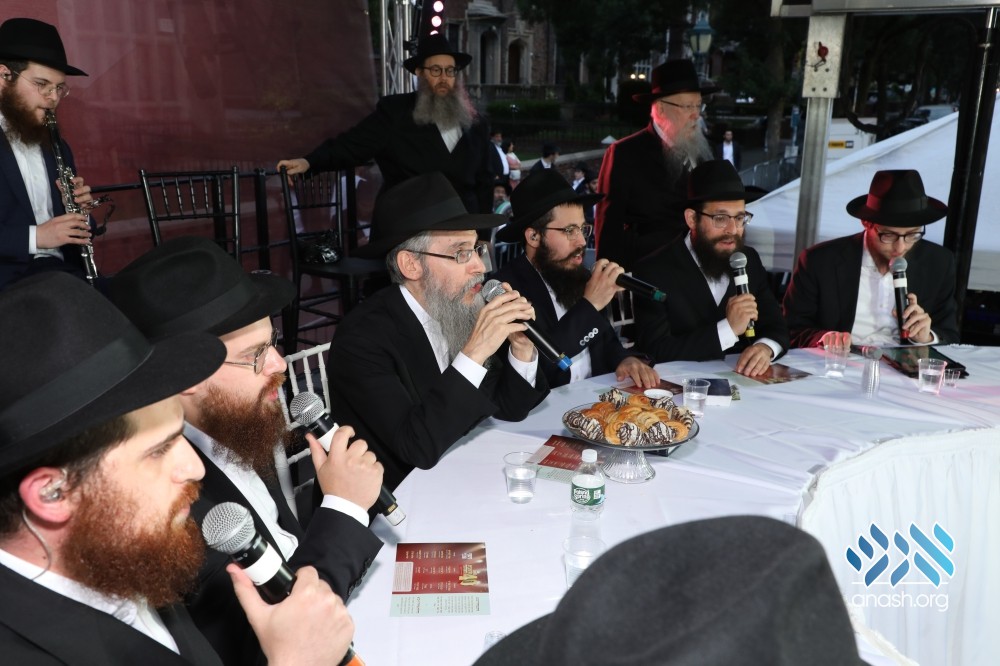

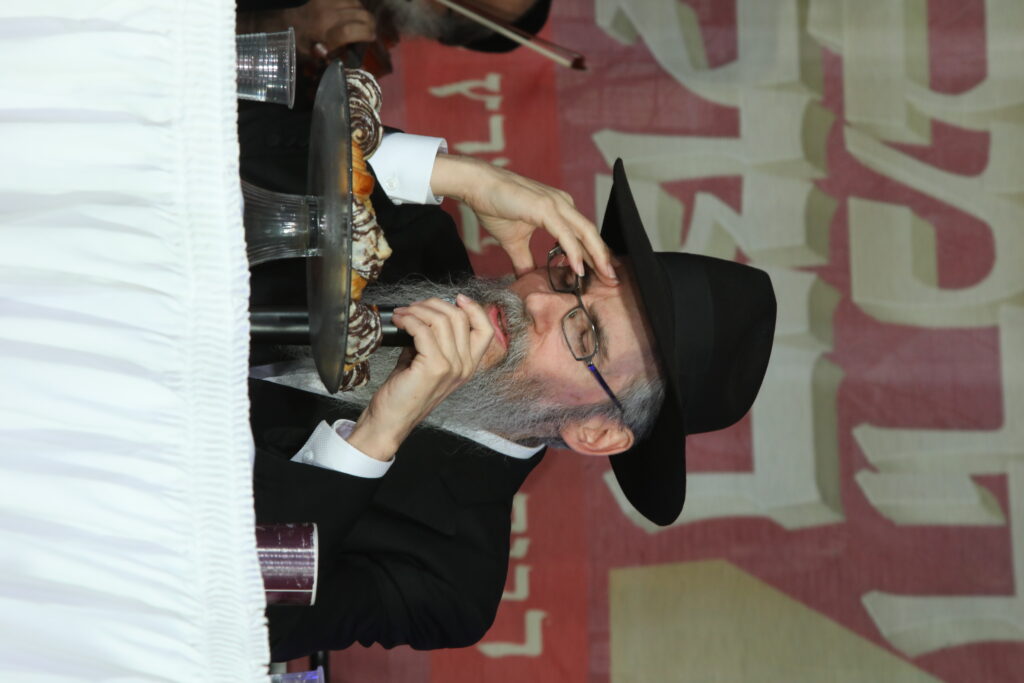
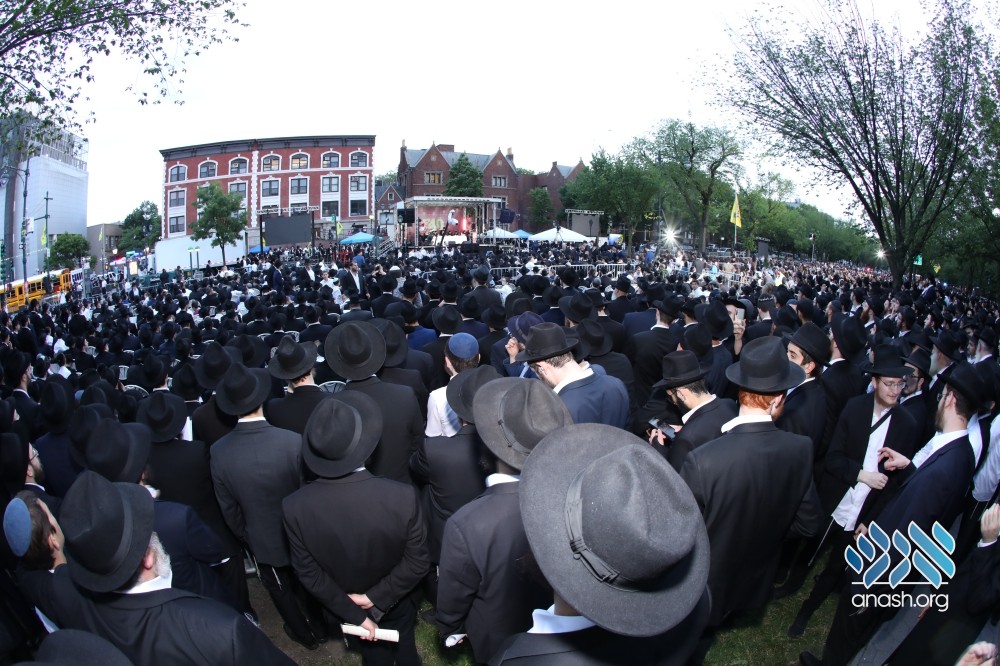


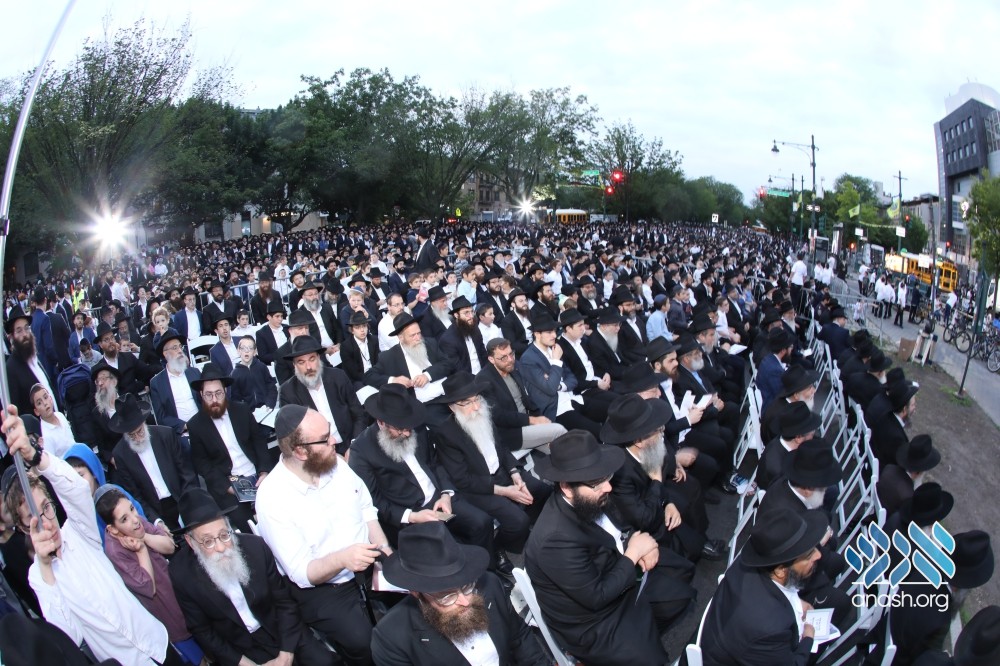

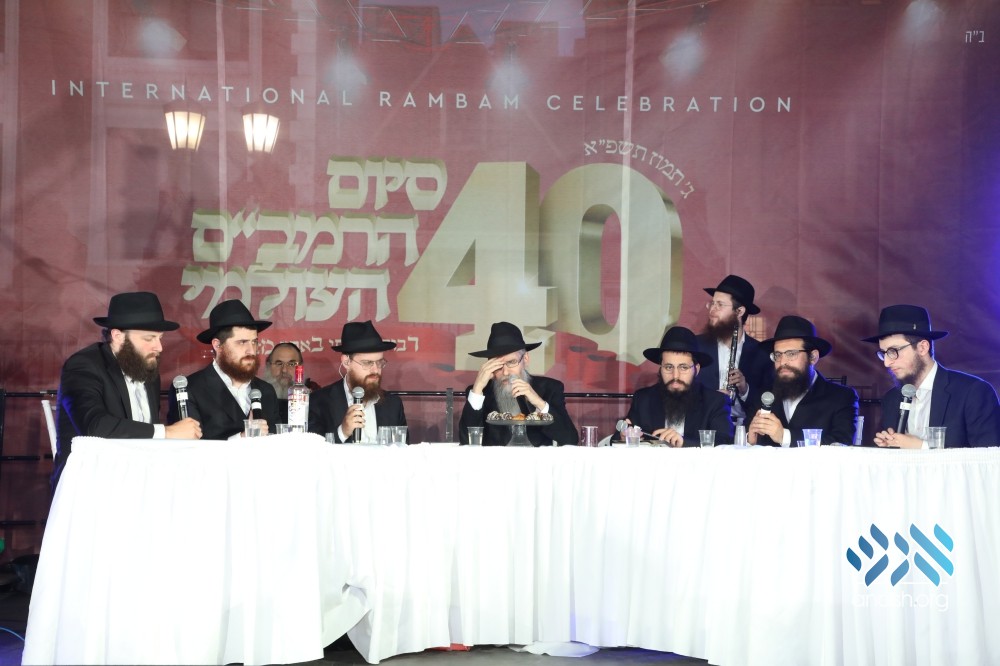
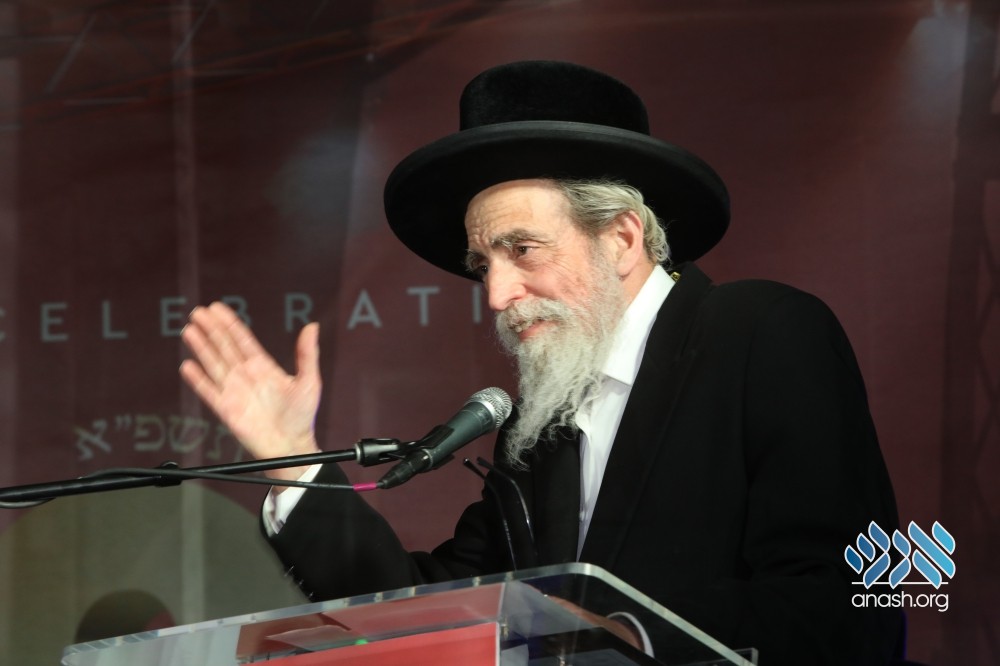
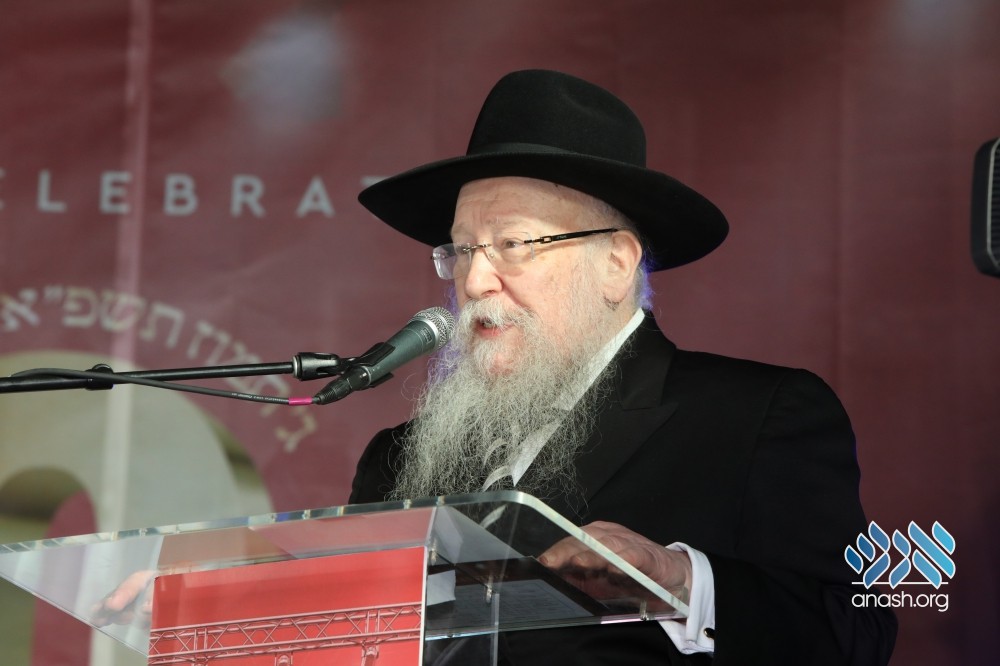
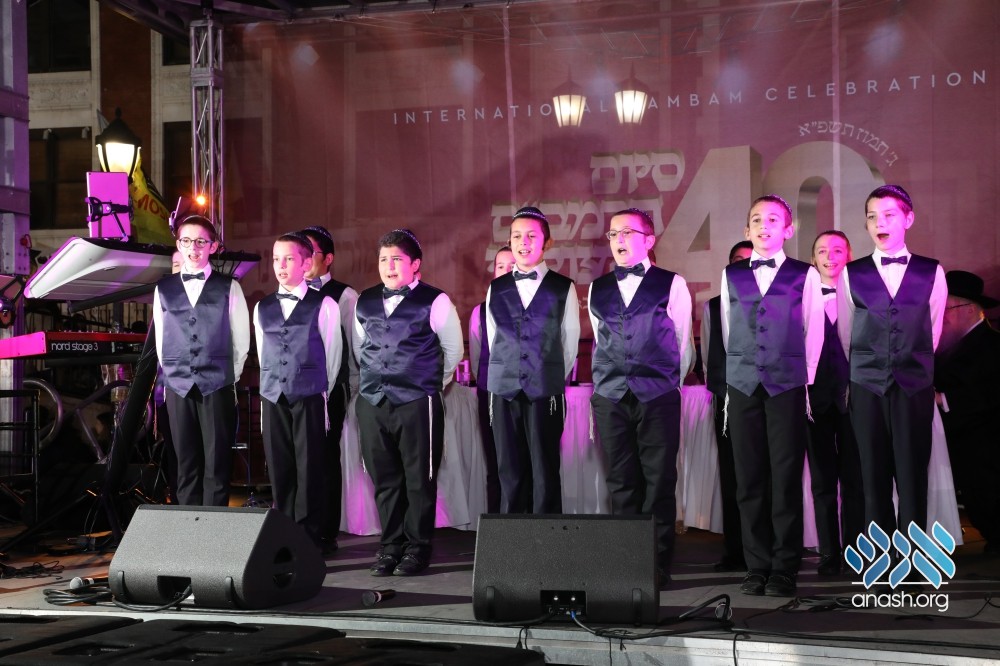


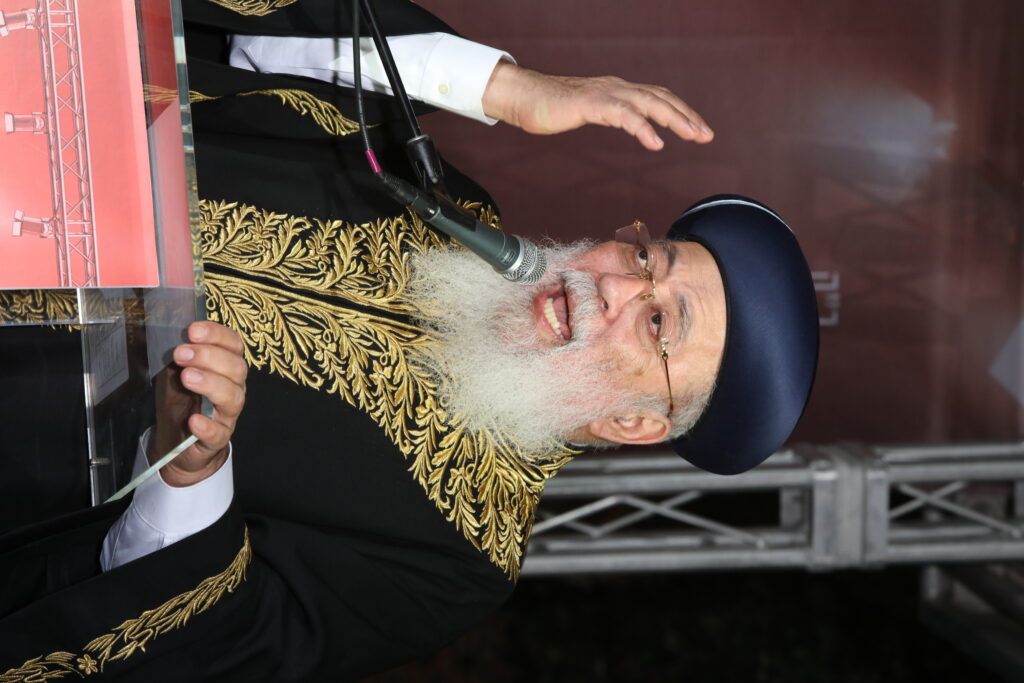
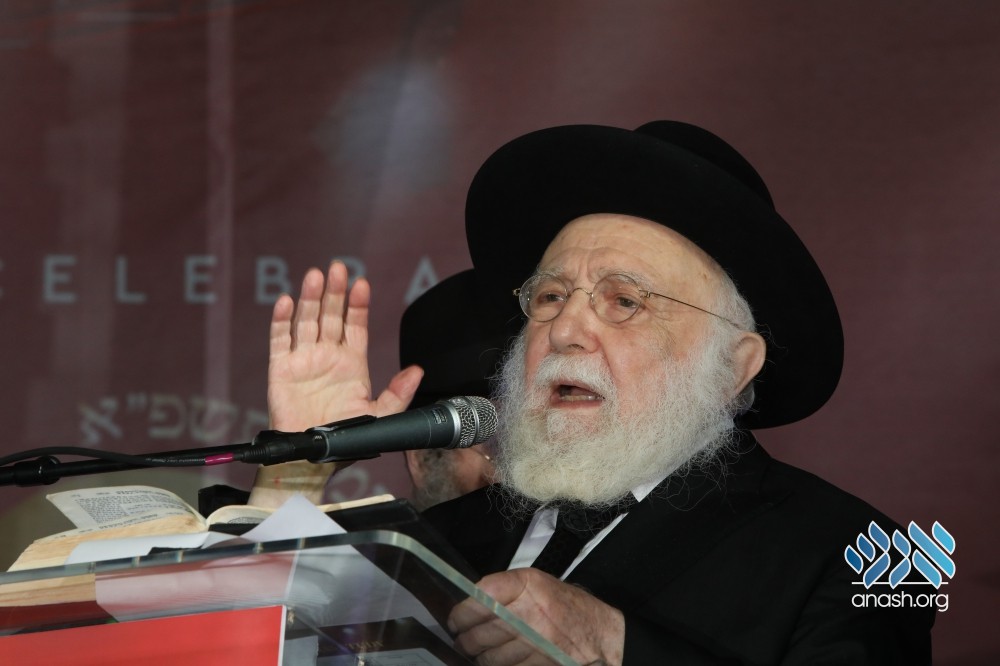
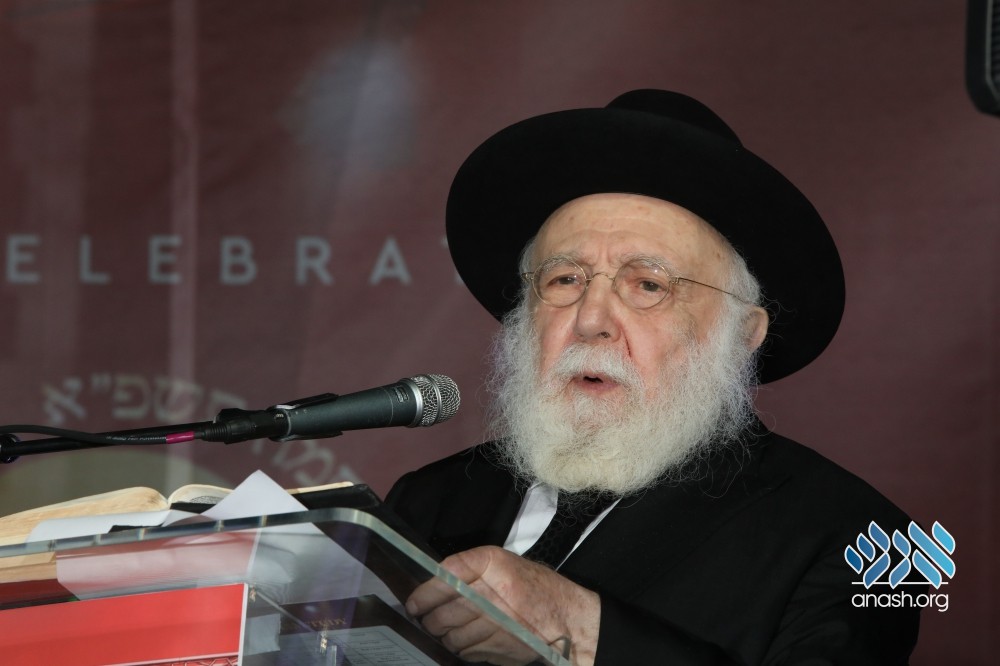
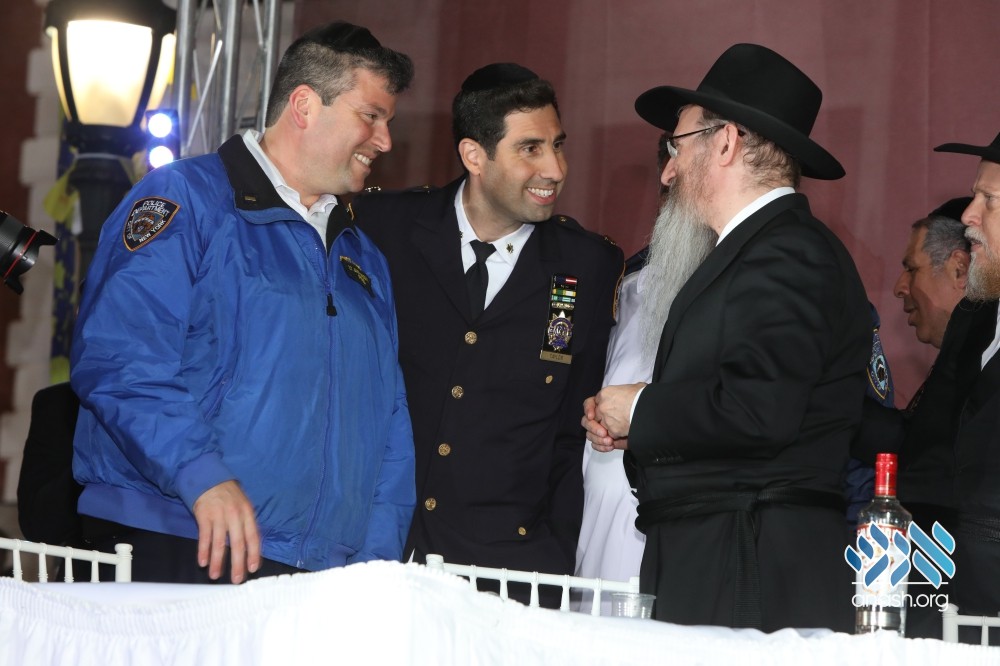
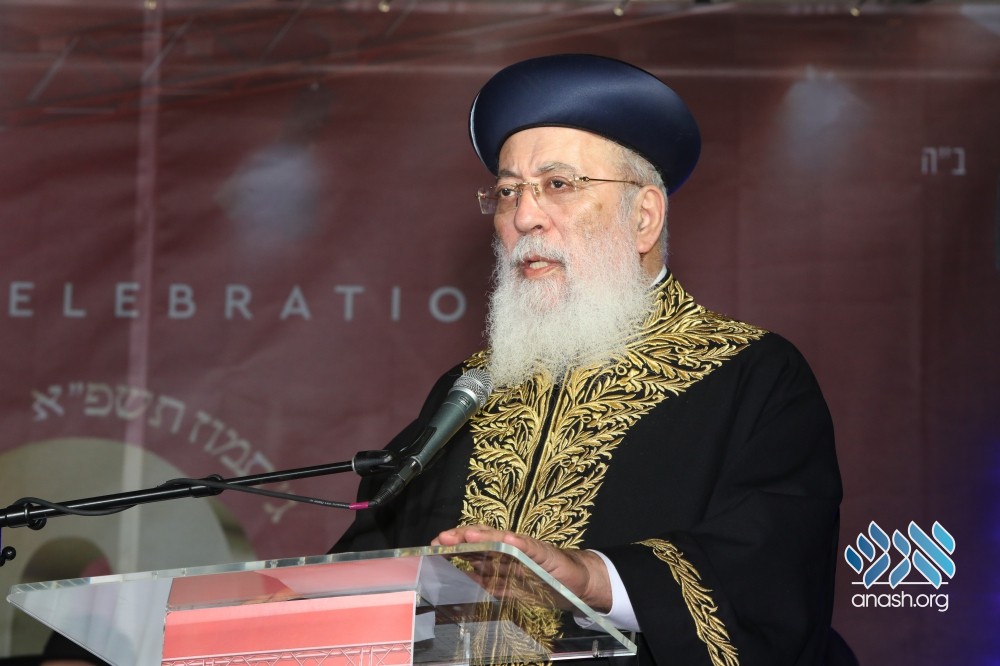
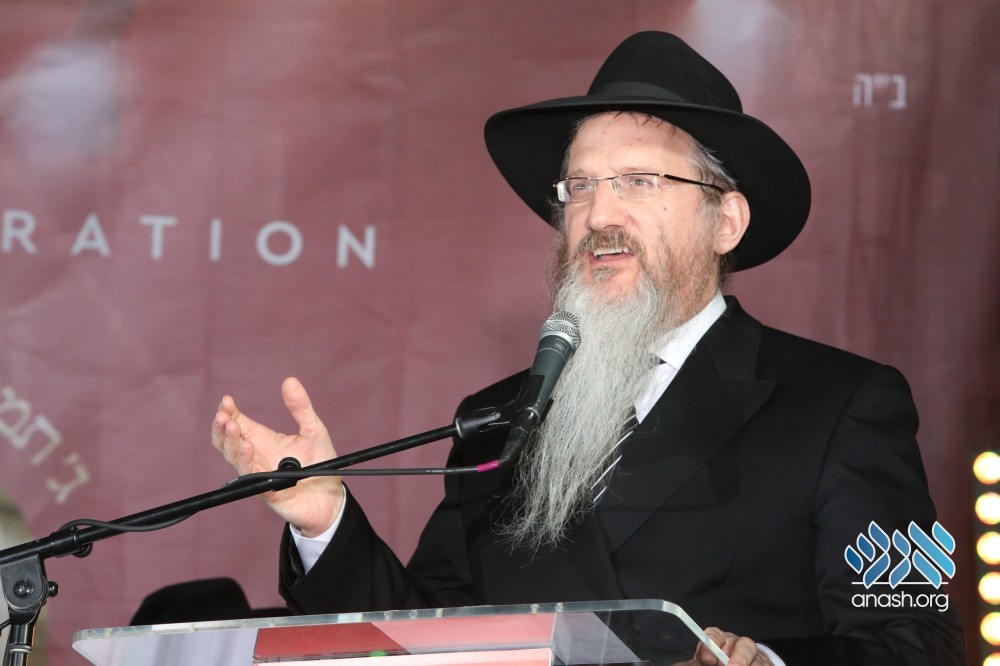
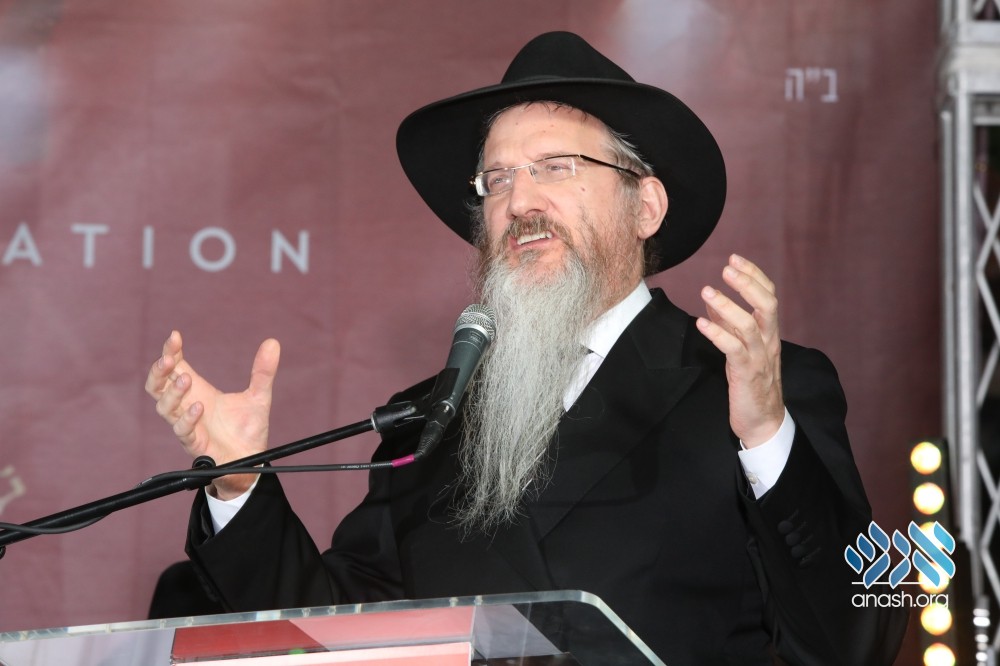


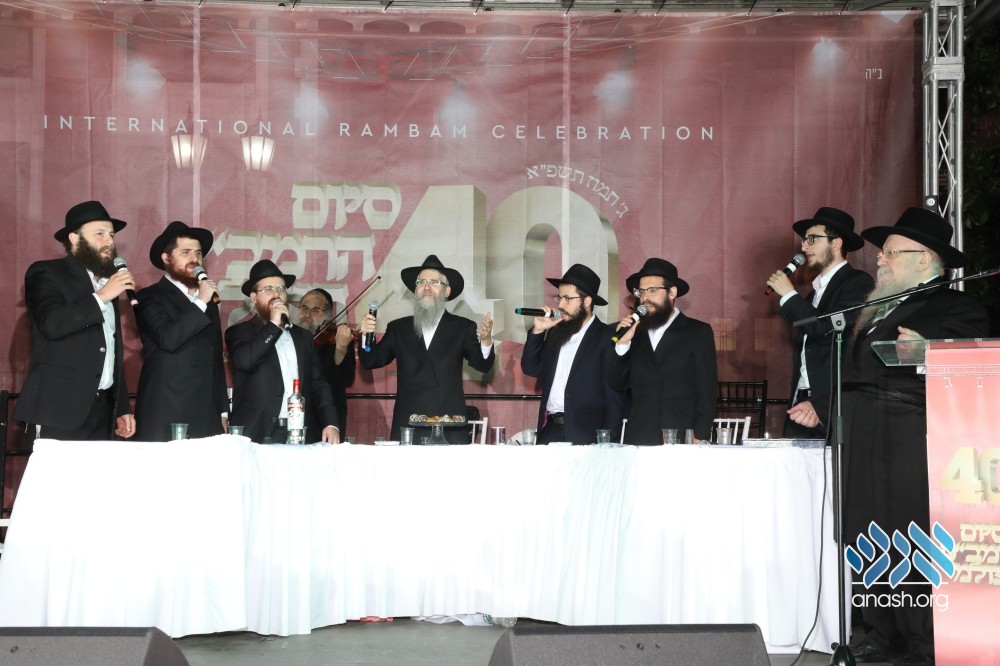

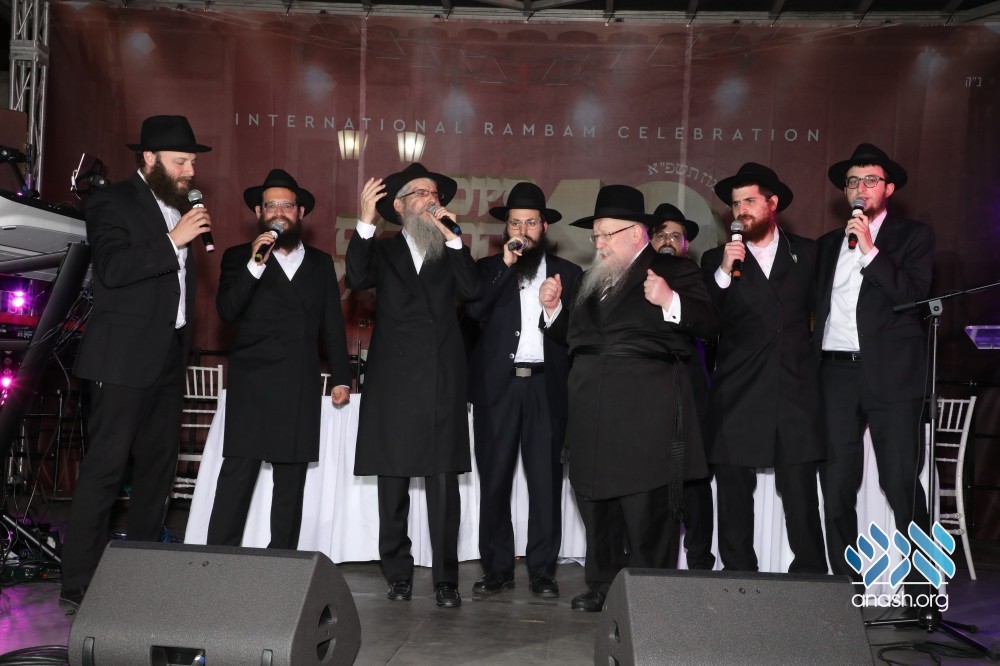
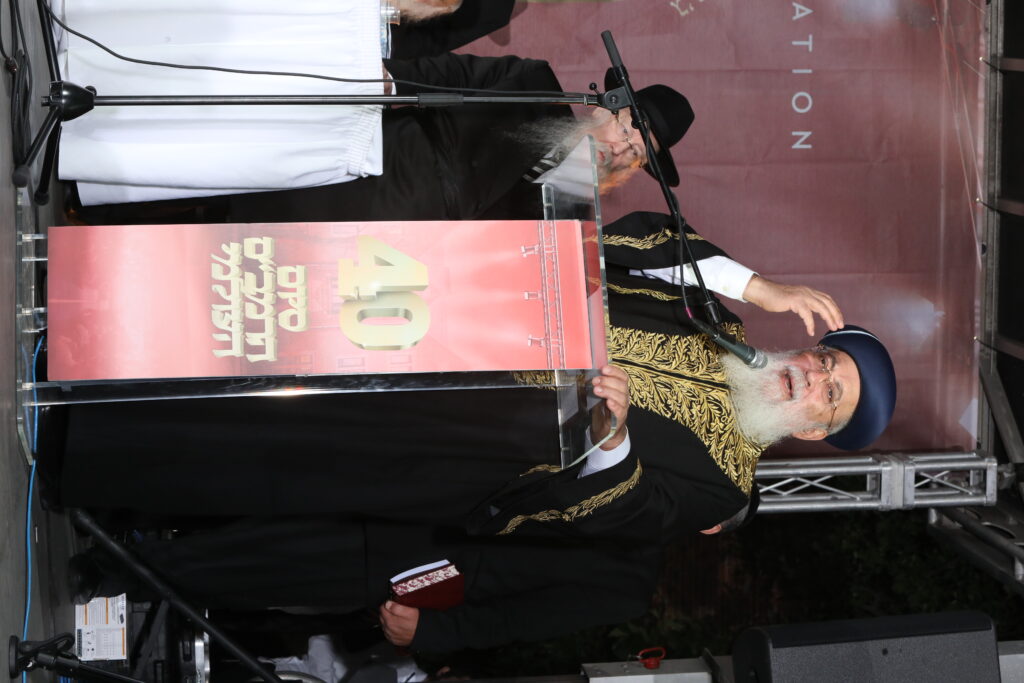



Discussion
In keeping in line with the Rabbonim's policies for websites, we do not allow comments. However, our Rabbonim have approved of including input on articles of substance (Torah, history, memories etc.)
We appreciate your feedback. If you have any additional information to contribute to this article, it will be added below.